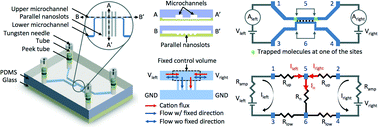Real-time dual-loop electric current measurement for label-free nanofluidic preconcentration chip
Abstract
An electrokinetic trapping (EKT)-based nanofluidic preconcentration device with the capability of label-free monitoring trapped biomolecules through real-time dual-loop electric current measurement was demonstrated. Universal current–voltage (I–V) curves of EKT-based preconcentration devices, consisting of two microchannels connected by ion-selective channels, are presented for functional validation and optimal operation; universal onset current curves indicating the appearance of the EKT mechanism serve as a confirmation of the concentrating action. The EKT mechanism and the dissimilarity in the current curves related to the volume flow rate (Q), diffusion coefficient (D), and diffusion layer (DL) thickness were explained by a control volume model with a five-stage preconcentration process. Different behaviors of the trapped molecular plug were categorized based on four modes associated with different degrees of electroosmotic instability (EOI). A label-free approach to preconcentrating (bio)molecules and monitoring the multibehavior molecular plug was demonstrated through real-time electric current monitoring, rather than through the use of microscope images.


 Please wait while we load your content...
Please wait while we load your content...